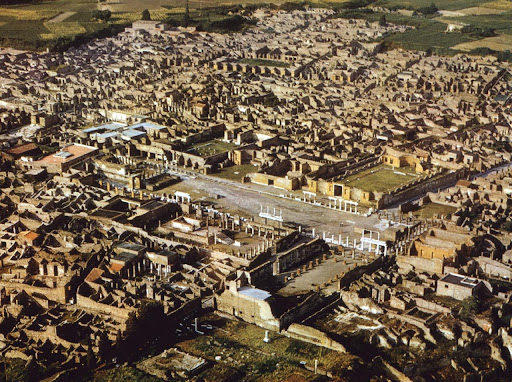 |
| (Photo: Remains of a Roman Camp in an English Field, yahoo) |
It seems that climate change does have its benefits after all! In an article published by Yahoo the other day, an abnormally dry season in the UK has allowed what are known as "crop marks" to become more visible. These marks occur when crops grow over disturbances in the soil caused by items buried in the archaeological record. Like the Nazca lines of Peru, they can only truly be seen from the air. To date, the crop marks have revealed camps, villages, roadways, and defensive structures, providing blueprints for a number of ancient settlements that have been preserved in time.
| (Photo: Body Casts in Pompeii, Picasa) |
The eruption of Mt. Vesuvius in 79CE is one of the best examples of the environment working in archaeology's favor. The well-known casts of the final moments of Pompeii's residents are undeniably haunting; some shield themselves with their arms, others contort in agony as they struggle to breathe. The most heartbreaking of all, mothers cling to their children as they prepare for the inevitable. As unfortunate as the eruption was for the people of Pompeii and the surrounding areas, it is a treasure trove of information for students of history.
 |
| (Photo: Modern-Day View of Ruins of Pompeii, Picasa) |
The volcanic ash from the eruption perfectly preserved the city of Pompeii, creating a time capsule of Roman life in the first century CE. Even the delicate mosaics and frescoes in the villas of the upper class remained intact, such as the famous artwork depicting Alexander the Great in the Battle of Issus.
 |
| (Photo: Battle of Issus, Wikimedia) |
These snapshots in time provided by the crop marks in the UK and the ash of Pompeii are invaluable due to the circumstances in which they were discovered. In both of these cases, artifacts and building footprints were found in their original context. Archaeologists do not have to assume the manner in which goods recovered from grave sites were used, or the layout of buildings in settlement sites. While the environmental factors contributing to the preservation of these sites can be less than favorable to those who experience them firsthand-- albeit dry spells are not nearly as devastating as volcanic eruptions-- they create a perfect storm that can be the archaeologist's best friend.
No comments:
Post a Comment